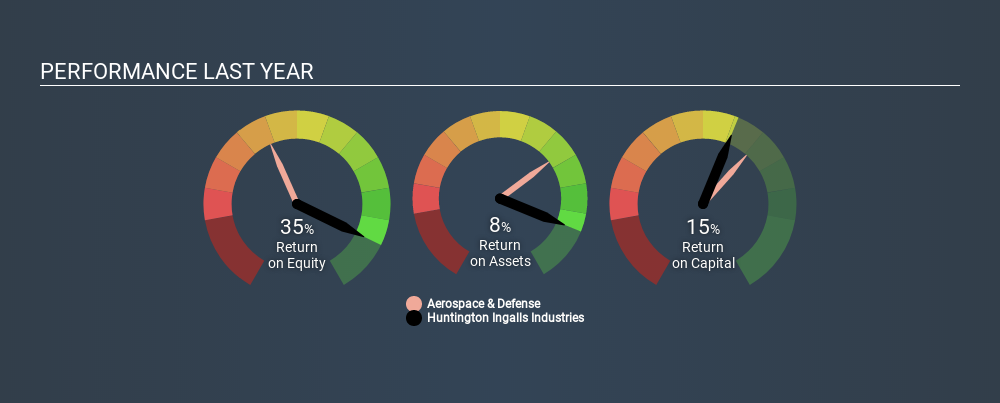- United States
- /
- Aerospace & Defense
- /
- NYSE:HII
Why Huntington Ingalls Industries, Inc.’s (NYSE:HII) Return On Capital Employed Is Impressive
Today we'll evaluate Huntington Ingalls Industries, Inc. (NYSE:HII) to determine whether it could have potential as an investment idea. In particular, we'll consider its Return On Capital Employed (ROCE), as that can give us insight into how profitably the company is able to employ capital in its business.
First of all, we'll work out how to calculate ROCE. Then we'll compare its ROCE to similar companies. Finally, we'll look at how its current liabilities affect its ROCE.
Understanding Return On Capital Employed (ROCE)
ROCE is a metric for evaluating how much pre-tax income (in percentage terms) a company earns on the capital invested in its business. In general, businesses with a higher ROCE are usually better quality. Ultimately, it is a useful but imperfect metric. Author Edwin Whiting says to be careful when comparing the ROCE of different businesses, since 'No two businesses are exactly alike.
How Do You Calculate Return On Capital Employed?
Analysts use this formula to calculate return on capital employed:
Return on Capital Employed = Earnings Before Interest and Tax (EBIT) ÷ (Total Assets - Current Liabilities)
Or for Huntington Ingalls Industries:
0.15 = US$755m ÷ (US$7.0b - US$1.9b) (Based on the trailing twelve months to December 2019.)
So, Huntington Ingalls Industries has an ROCE of 15%.
See our latest analysis for Huntington Ingalls Industries
Is Huntington Ingalls Industries's ROCE Good?
ROCE is commonly used for comparing the performance of similar businesses. In our analysis, Huntington Ingalls Industries's ROCE is meaningfully higher than the 10% average in the Aerospace & Defense industry. We would consider this a positive, as it suggests it is using capital more effectively than other similar companies. Independently of how Huntington Ingalls Industries compares to its industry, its ROCE in absolute terms appears decent, and the company may be worthy of closer investigation.
The image below shows how Huntington Ingalls Industries's ROCE compares to its industry, and you can click it to see more detail on its past growth.

It is important to remember that ROCE shows past performance, and is not necessarily predictive. ROCE can be deceptive for cyclical businesses, as returns can look incredible in boom times, and terribly low in downturns. ROCE is, after all, simply a snap shot of a single year. What happens in the future is pretty important for investors, so we have prepared a free report on analyst forecasts for Huntington Ingalls Industries.
Huntington Ingalls Industries's Current Liabilities And Their Impact On Its ROCE
Current liabilities are short term bills and invoices that need to be paid in 12 months or less. Due to the way the ROCE equation works, having large bills due in the near term can make it look as though a company has less capital employed, and thus a higher ROCE than usual. To counteract this, we check if a company has high current liabilities, relative to its total assets.
Huntington Ingalls Industries has total assets of US$7.0b and current liabilities of US$1.9b. Therefore its current liabilities are equivalent to approximately 27% of its total assets. A fairly low level of current liabilities is not influencing the ROCE too much.
Our Take On Huntington Ingalls Industries's ROCE
This is good to see, and with a sound ROCE, Huntington Ingalls Industries could be worth a closer look. Huntington Ingalls Industries shapes up well under this analysis, but it is far from the only business delivering excellent numbers . You might also want to check this free collection of companies delivering excellent earnings growth.
There are plenty of other companies that have insiders buying up shares. You probably do not want to miss this free list of growing companies that insiders are buying.
If you spot an error that warrants correction, please contact the editor at editorial-team@simplywallst.com. This article by Simply Wall St is general in nature. It does not constitute a recommendation to buy or sell any stock, and does not take account of your objectives, or your financial situation. Simply Wall St has no position in the stocks mentioned.
We aim to bring you long-term focused research analysis driven by fundamental data. Note that our analysis may not factor in the latest price-sensitive company announcements or qualitative material. Thank you for reading.
About NYSE:HII
Huntington Ingalls Industries
Designs, builds, overhauls, and repairs military ships in the United States.
Undervalued established dividend payer.
Similar Companies
Market Insights
Community Narratives



